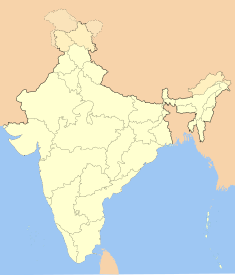Anuppur
| ?Anuppur Madhya Pradesh • India | |
| Coordinates: | |
| Oras zona | IST (UTC+5:30) |
| Lualas • Kátas |
• 505 m (1,657 ft) |
| Distritu | Anuppur |
| Populasiun | 16,397 (2001) |
| Website: anuppur.nic.in/ | |
Coordinates: Ing Anuppur balen ya king dake nang pangulu-aslagan (northeastern) ning estado ning Madhya Pradesh king kalibudtang (central) India. Sentru neng kapanibalan ning Anuppur District. Sadia, kayabe ya king Shahdol district.
Dalerayan
mag-editIndira Gandhi National Tribal University, Amarkantak, District Anuppur(Central University)
An Act was passed in Indian parliament which was published in the Gazette of India, Part II, section I, on 20 December 2007 by the virtue of which Indira Gandhi National Tribal University Act, 52, 2007. The then M.H.R.D. minister, Shri Arjun Singh laid the foundation stone on 19 April 2008 at Amarkantak. The government of India 7 July 2008, circulated the order of appointment of the founder vice-chancellor of the university. In compliance of this order, Prof. Chandra Deo Singh took the post on 08.07.2008. It is fully granted by the government of India, through University Grant Commission. Different from other universities, Indira Gandhi National Tribal University, Amarkantak will have its regional campuses in tribal-dominated states. These campuses will be in tribal areas so that tribal students can have easy access to higher education and promote themselves and their interests so that they can occupy a remarkable place in the mainstream of society. The regional campuses will preserve the tribal art, culture, and traditional medicinal knowledge of the tribes and have been entrusted with the task of using it for the benefit of all.Writing by Dr.Mohan Lal chadhar, Indira Gandhi National Tribal University, District Anuppur (M.P.)484886 The tribal people are rich in cultural heritage and skill of art and craft, but they are marginalised in respect to higher education as well as in other walks of life. Now in the present age of globalisation the world has shrunk into a village as the society has advanced in technology. But the tribes, who are the custodians of Indian culture in a real sense, are far behind in this race of advancement. To rescue them from the present plight, the university has put before itself the following aims and objectives: To provide avenues of education, especially higher education and research facilities primarily for the tribal population of India. To disseminate and advance knowledge by providing instructional and research facilities in tribal art, tradition, culture, language, medicinal systems, customs, forest based economic activities, flora, fauna and advancement in technologies relating to the natural resources of the tribal areas. To collaborate with national and international universities and organisations, especially for undertaking cultural studies and research on tribal communities. To formulate tribal centric development models, publish reports and monographs and to organised conferences and seminars on issues relating to tribes and to provide inputs to policy matters in different spheres. To take appropriate measures for promoting the members of tribal communities capable of managing, administering and looking after their own needs by access to higher education through a university of their own. To disseminate and advance knowledge by providing instructional and research facilities in such other branches of learning as it may deem fit. To take appropriate measures for promoting innovations in teaching learning process in inter-disciplinary studies and researches and to pay special attention to the improvement of social, educational and economic conditions and welfare of the scheduled tribes within the Union of India. In view of the aims and objectives the major thrust will be on providing more opportunity for the tribes. However, the university is open to all. Officers of the university are Visitor Shri Pranab Mukherjee, His Excellency, President of India; chancellor Shri S.M. Jharwal (I.E.S. retd.); vice-chancellor Prof. C.D. Singh;
University Faculty 1. Faculty of Computronics 2. Faculty of Commerce and Management 3. Faculty of Law 4. Faculty of Pharmacy 5. Faculty of Science 6. Faculty of Journalism and Mass Communication 7. Faculty of Social Science 8. Faculty of Tribal Studies 9. Faculty of Humanities and Philology 10. Faculty of Education University Existing Departments Faculty of Social Sciences 1.Department of Ancient Indian History, Culture & Archaeology 2.Department of Economics 3.Department of Sociology and Social Anthropology 4.Department of Geography and Regional Development 5.Department of History 6.Department of Political Science & Human Rights Faculty of Sciences 1. Department of Biotechnology 2. Department of Botany. 3.Department of Zoology 4.Department of Chemistry 6.Department of Environment Science Faculty of Computerronics Department of Computer Science Faculty of Commerce and Management 1.Department of Commerce 2.Department of Business Management 3.Department of Tourism, Hospitality and Hotel Management Faculty of Humanities and Philology 1.Department of English and Foreign Languages 2.Department of Philosophy 3.Department of Applied Psychology Faculty of Tribal Studies 1. Department of Folk History, Museology and Traditional Medicine 2. Department of Tribal Art, Folk Literature and Culture Faculty of Journalism and Mass Communication 1.Department of Journalism and Mass Communication Departments for Next Session 1. Department of Education. 2. Department of Forest Management 3. Department of Geology and Mineralogy 4. Department of Home Science and Nutrition 5. Department of Information Technology. 6. Department of Law ( Five Years Integrated Course) 7. Department of Mathematics and Statistics. 8. Department of Meteorology. 9. Department of Pharmacy (D.Pharma and B. Pharma) 10. Department of Physics. 11. Department of Physical Education 12. Department of Social Work 13. Department of Tribal Languages and Comparative linguistics.
